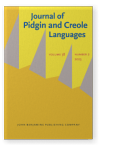Vol. 38:2 (2023) ► pp.207–262
Noun phrases in mixed Martinican Creole and French
Evidence for an Underspecified Language Model
Contact between French and Martinican Creole (MC) takes place in a society where bilingualism is the standard, in a situation of constant language mixing. French and MC, although related, show significant typological divergences on some specific features, e.g. the order between noun and definite determiner in the noun phrase, or the use of a linker to mark a possessive embedded noun phrase. In this paper, I explore the possible combination of the different values of these features in mixed noun phrases occurring in corpora. I inquire about the possible parameters which may influence the outcome and explain the relative frequencies of these different combinations. It appears that there is a partially common pool of elementary structures. Many utterances fall into the category termed by Muysken (2000) ‘congruent lexicalization’. I also observe that apparent complex double embeddings have an internal logic, as they result from adjunction of multi-word modifiers. Finally I propose a model which accounts for the observed occurrences by postulating a level in the speech generation process where language itself is underspecified, and where it is in a position to be specified on the fly by contextual factors, coming either from the lexicon or from the constructional frame.
Article outline
- 1.Introduction and context: French and Creole in the Martinique
- 1.1French and Martinican Creole (MC)
- 1.2Language contact situation
- 1.3Diglossia or Creole continuum: What is in the language mix?
- 1.4Data used for the present study
- 2.Possession and determination in the noun phrase
- 2.1Possession
- 2.2Determination
- 3.Noun phrase configurations in language mixing
- 3.1Congruent and non-congruent structures
- 3.2Purported constraints on the possible combinations
- 4.Observations in actual corpora
- 4.1As evidenced in mixed language corpora
- 4.2Embedded structures
- 5.Discussion
- 5.1Suspected cases of doubling
- 5.2Limits of the ‘constraints on code-switching’ approach: Congruent lexicalization
- 5.3The difference between substitution and adjunction; derivation trees
- 6.Underspecified language model
- Conclusion
- Remotivation through language contact
- Congruent lexicalization
- Importance of the derivation history to understand multiple switches
- An underspecified language model
- Acknowledgements
- Notes
- Abbreviations
-
References
